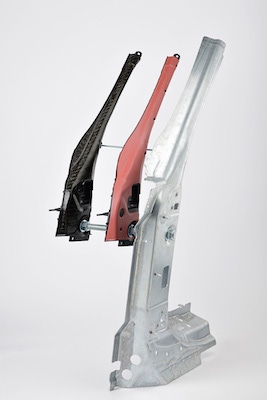Continuous-fiber-reinforced thermoplastic composites contribute to lightweight car design; extremely high requirements for load-bearing capacity and crash performance.
September 26, 2019

The potential of Tepex, a line of continuous-fiber-reinforced thermoplastic composite materials from Lanxess, for use in lightweight applications extends to the design of structural components in passenger cars, which need to be capable of meeting very stringent requirements in the event of a crash. One example of this is a lightweight A-pillar developed by Porsche’s 3D hybrid design.
The A-pillar is intended for use in cars such as convertibles and roadsters and is being employed for the first time in the Porsche 911 Cabriolet. The pillar contains an insert made from high-strength steel. This is supported from the inside by a formed blank of the polyamide-6-based Tepex dynalite 102-RG600(6)/47% and by a ribbed structure made from Durethan AKV30H2.0, which is based on polyamide 66 and contains short glass fibers.
|
Lightweight A-pillar is reinforced by polyamide-6-based Tepex dynalite 102-RG600(6)/47% and by a ribbed structure made from Durethan AKV30H2.0, which is based on polyamide 66 and contains short glass fibers. |
This structure is heat activated with the L-5235 structural foam developed by L&L Products. The strength and rigidity of the hybrid insert ensure that the A-pillar is just as good at withstanding rollovers as previous designs featuring high-strength steel tubes. However, it is around five kilograms lighter. The weight reduction is achieved in the greenhouse area of the vehicle, lowering the car’s center of gravity and thereby improving vehicle dynamics.
“The excellent mechanical performance of the hybrid A-pillar demonstrates that hybrid inserts based on steel sheet, Tepex blanks, polyamide 6 or polyamide 66 variations of Durethan as a back-injection material and on a structural foam such as L-5235 also offer considerable potential for use in structural lightweight vehicle body design. That applies to electric vehicles in particular, as their heavy batteries give them a high impact mass,” explains Henrik Plaggenborg, head of Tepex Automotive at the Lanxess High Performance Materials (HPM) business unit. “The weight reduction also extends the range of electric vehicles that use this technology.”
Other potential applications for the hybrid composite elements include reinforcing cross members and side members, B- and C-pillars, load-bearing battery parts or door components that are critical to safety.
The hybrid composite elements are developed and manufactured by L&L Products at its site in Strasbourg in the Alsace region of France. The US company has made a name for itself through innovations in static sealing, acoustics, vibration reduction, structural reinforcement and composite components for the automotive and aerospace industries, for example. The first step in the manufacture of the reinforcing elements involves forming and overmolding the Tepex blanks in a single operation using the hybrid molding technology. The resultant composite component is then coated with an epoxy-based foam bonding system that expands in response to heat. The coated part is mounted on the body and goes through the cathodic dip coating (KTL) process with it. The high temperatures of the KTL process cause the structural foam to expand and bond with the high-strength sheet steel, which is also affixed to the A-pillar casing, to produce the reinforcing hybrid insert. This last step takes place in an entirely automated manufacturing process that was developed by Porsche and is subject to ongoing quality control.
Through its HiAnt customer service operation, Lanxess provided Porsche and L&L Products with extensive support in the development of the hybrid inserts and the A-pillar. “Services included simulating the forming (draping) of the Tepex blanks, simulating filling for back-injection and calculating warpage. We also determined material characteristics to simulate the mechanical behavior of the A-pillar and made these figures available to Porsche,” said Jean-Marie Olivé, expert in application development at HPM.
Tepex dynalite is already used in series production at Porsche for another safety-critical component. It is used in the hybrid molding process to make the brake pedal for cars including the Porsche 918 Spyder, Porsche Macan, and Porsche Panamera NF. The component is the first all-plastic brake pedal to be used in series production and took first prize in the Body Interior category of the 2016 Automotive Innovation Awards, organized by the Central Europe division of the Society of Plastics Engineers (SPE).
About the Author(s)
You May Also Like





